不定式的被动式的概念
- 格式:doc
- 大小:19.50 KB
- 文档页数:5
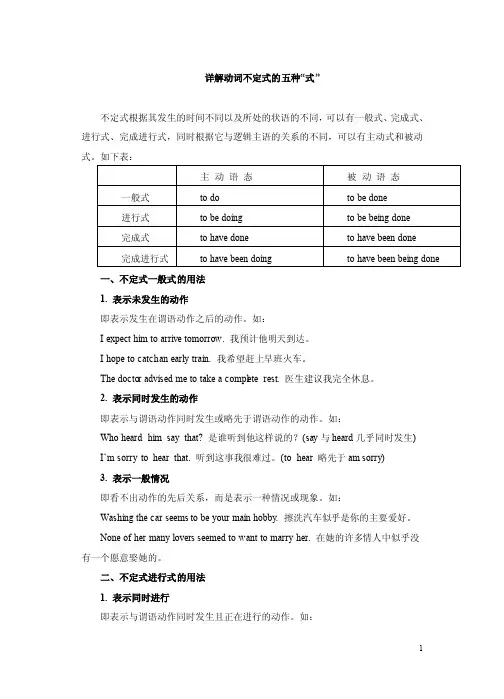
详解动词不定式的五种“式”不定式根据其发生的时间不同以及所处的状语的不同,可以有一般式、完成式、进行式、完成进行式,同时根据它与逻辑主语的关系的不同,可以有主动式和被动式。
如下表:一、不定式一般式的用法1. 表示未发生的动作即表示发生在谓语动作之后的动作。
如:I expect him to arrive tomorr ow. 我预计他明天到达。
I hope to catchan earlytrain.我希望赶上早班火车。
The doctor advise d me to take a comple te rest. 医生建议我完全休息。
2. 表示同时发生的动作即表示与谓语动作同时发生或略先于谓语动作的动作。
如:Who heardhim say that? 是谁听到他这样说的?(say与he ard几乎同时发生) I‟msorryto hear that. 听到这事我很难过。
(to hear 略先于amsorry)3. 表示一般情况即看不出动作的先后关系,而是表示一种情况或现象。
如:Washin g the car seemsto be your main hobby.擦洗汽车似乎是你的主要爱好。
None of her many lovers seemed to want to marryher. 在她的许多情人中似乎没有一个愿意娶她的。
二、不定式进行式的用法1. 表示同时进行即表示与谓语动作同时发生且正在进行的动作。
如:He seemsto be follow ing us. 他似乎在跟着我们。
He preten ded to be lookin g for a book. 他假装在找书。
I happen ed to be lookin g out of the window when they arrive d. 他们到达时我碰巧正向窗外望去。
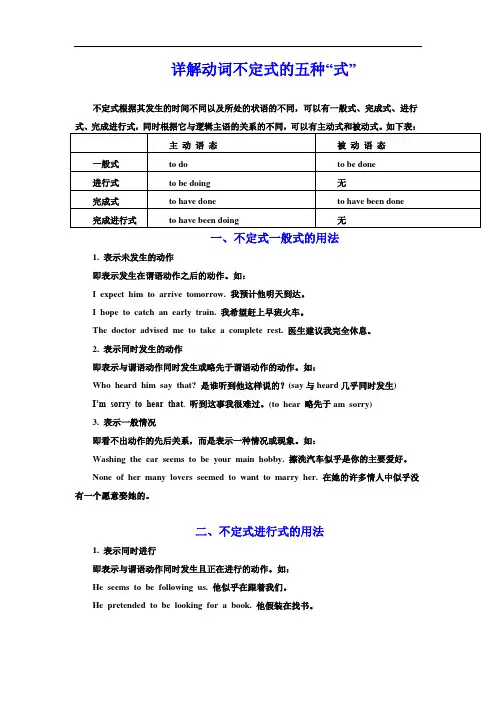
详解动词不定式的五种“式”不定式根据其发生的时间不同以及所处的状语的不同,可以有一般式、完成式、进行式、完成进行式,同时根据它与逻辑主语的关系的不同,可以有主动式和被动式。
如下表:一、不定式一般式的用法1. 表示未发生的动作即表示发生在谓语动作之后的动作。
如:I expect him to arrive tomorrow. 我预计他明天到达。
I hope to catch an early train. 我希望赶上早班火车。
The doctor advised me to take a complete rest. 医生建议我完全休息。
2. 表示同时发生的动作即表示与谓语动作同时发生或略先于谓语动作的动作。
如:Who heard him say that? 是谁听到他这样说的?(say与heard几乎同时发生)I’m sorry to hear that. 听到这事我很难过。
(to hear 略先于am sorry)3. 表示一般情况即看不出动作的先后关系,而是表示一种情况或现象。
如:Washing the car seems to be your main hobby. 擦洗汽车似乎是你的主要爱好。
None of her many lovers seemed to want to marry her. 在她的许多情人中似乎没有一个愿意娶她的。
二、不定式进行式的用法1. 表示同时进行即表示与谓语动作同时发生且正在进行的动作。
如:He seems to be following us. 他似乎在跟着我们。
He pretended to be looking for a book. 他假装在找书。
I happened to be looking out of the window when they arrived. 他们到达时我碰巧正向窗外望去。
2. 表示将来正如可用进行时态表示将来意义一样,不定式的进行式有时也可表示将来。
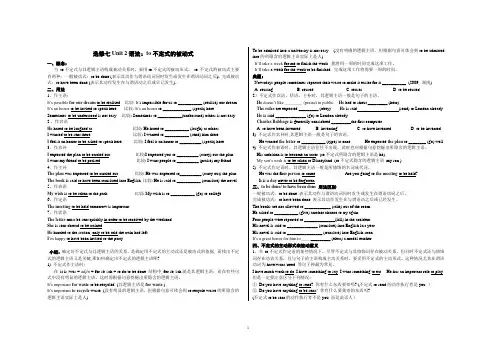
选修七Unit 2语法:to不定式的被动式一、概念:当to不定式与其逻辑主语构成被动关系时,要用to不定式的被动形式。
to 不定式的被动式主要有两种:一般被动式:to be done (表示其动作与谓语动词同时发生或发生在谓语动词之后); 完成被动式:to have been done (表示其动作发生在与谓语动之后或早已发生)。
二、用法1、作主语:It’s possible for our dream to be realized比较: It’s impossible for us to ___________ (realize) our dream. It’s an honor to be invited to speak here.比较: It’s an honor to _____________ (speak) here.Sometimes to be understood is not easy.比较: Sometimes to___________(understand) others is not easy 2.、作宾语He hated to be laughed at.比较: He hated to ___________(laugh) at others.I wanted to be sent there.比较: I wanted to ___________(send) him there.I feel it an honor to be asked to speak here.比较: I feel it an honor to __________(speak) here.3、作宾补I expected the plan to be carried out. 比较:I expected you to __________(carry) out the plan.I want my friend to be praised.比较: I want people to __________(praise) my friend.4、作主补The plan was expected to be carried out.比较: He was expected to__________ (carry out) the plan.The book is said to have been translated into English 比较: He is said to ___________ (translate) the novel.5、作表语My wish is to be taken to the park.比较: My wish is to ___________ (go) to college.6、作定语The meeting to be held tomorrow is important.7、作状语The letter must be sent quickly in order to be received by the weekend.She is sent abroad to be trained.He hurried to the station, only to be told the train had left.I’m happy to have been invited to the party.小结:确定好不定式与其逻辑主语的关系,是确定用不定式的主动式还是被动式的依据, 而找出不定式的逻辑主语又是关键,那如何确定出不定式的逻辑主语呢?1)不定式作主语时:在it is /was + adj/n.+ for sb./sth + to do/to be done 结构中,for sb./sth就是其逻辑主语;而在有些句式中没有明显的逻辑主语,这时需根据句意挖掘出所隐含的逻辑主语。

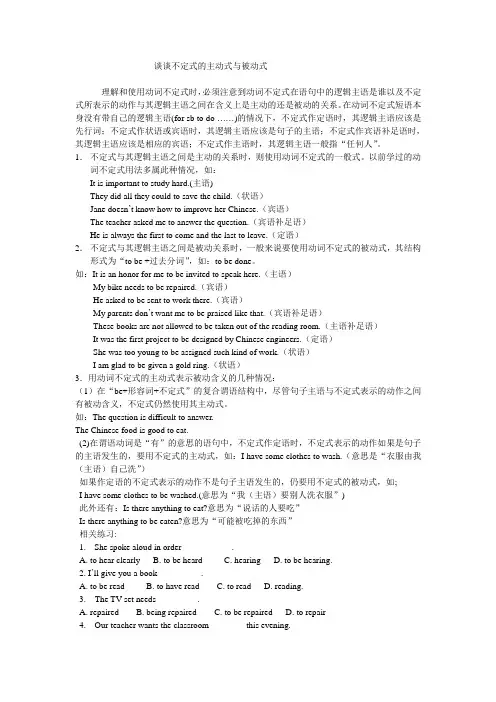
谈谈不定式的主动式与被动式理解和使用动词不定式时,必须注意到动词不定式在语句中的逻辑主语是谁以及不定式所表示的动作与其逻辑主语之间在含义上是主动的还是被动的关系。
在动词不定式短语本身没有带自己的逻辑主语(for sb to do ……)的情况下,不定式作定语时,其逻辑主语应该是先行词;不定式作状语或宾语时,其逻辑主语应该是句子的主语;不定式作宾语补足语时,其逻辑主语应该是相应的宾语;不定式作主语时,其逻辑主语一般指“任何人”。
1.不定式与其逻辑主语之间是主动的关系时,则使用动词不定式的一般式。
以前学过的动词不定式用法多属此种情况,如:It is important to study hard.(主语)They did all they could to save the child.(状语)Jane doesn’t know how to improve her Chinese.(宾语)The teacher asked me to answer the question.(宾语补足语)He is always the first to come and the last to leave.(定语)2.不定式与其逻辑主语之间是被动关系时,一般来说要使用动词不定式的被动式,其结构形式为“to be +过去分词”,如:to be done。
如:It is an honor for me to be invited to speak here.(主语)My bike needs to be repaired.(宾语)He asked to be sent to work there.(宾语)My parents don’t want me to be praised like that.(宾语补足语)These books are not allowed to be taken out of the reading room.(主语补足语)It was the first project to be designed by Chinese engineers.(定语)She was too young to be assigned such kind of work.(状语)I am glad to be given a gold ring.(状语)3.用动词不定式的主动式表示被动含义的几种情况:(1)在“be+形容词+不定式”的复合谓语结构中,尽管句子主语与不定式表示的动作之间有被动含义,不定式仍然使用其主动式。
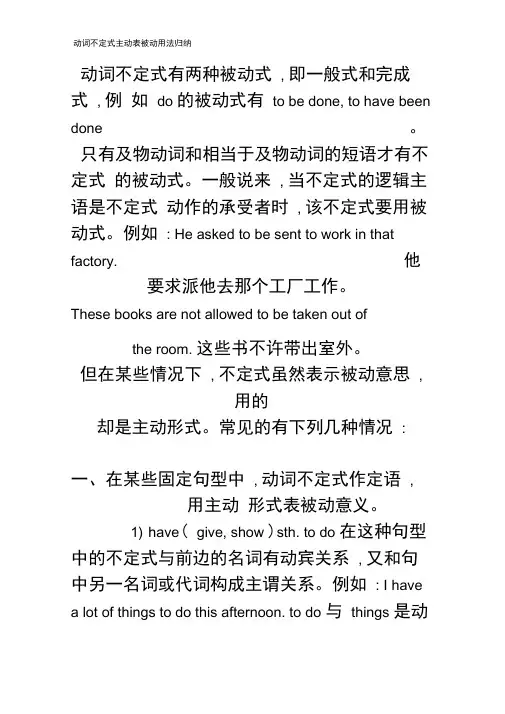
动词不定式有两种被动式, 即一般式和完成式, 例如do 的被动式有to be done, to have beendone 。
只有及物动词和相当于及物动词的短语才有不定式的被动式。
一般说来, 当不定式的逻辑主语是不定式动作的承受者时, 该不定式要用被动式。
例如: He asked to be sent to work in that factory. 他要求派他去那个工厂工作。
These books are not allowed to be taken out ofthe room. 这些书不许带出室外。
但在某些情况下, 不定式虽然表示被动意思,用的却是主动形式。
常见的有下列几种情况:一、在某些固定句型中, 动词不定式作定语,用主动形式表被动意义。
1) have( give, show )sth. to do 在这种句型中的不定式与前边的名词有动宾关系, 又和句中另一名词或代词构成主谓关系。
例如: I have a lot of things to do this afternoon. to do 与things 是动宾关系, 与I 是主谓关系。
否则, 在表示被动意义时, 仍需要被动式。
试比较:Have you anything to do this afternoon? 今天下午你有事要做吗?( to do 是由you 发出的)Have you anything to be taken to your parents? 你有要带给你父母的xx 吗? (谁带不得而知)再如:Please get me something to read. 请给我弄点读的材料。
He'll show you the right path to take. 他会给你指出要走的正确的路。
2) It ( This, That )+be+a/an+adj. +n. +to do在这种句型中, 不定式与前面的名词有动宾关系。
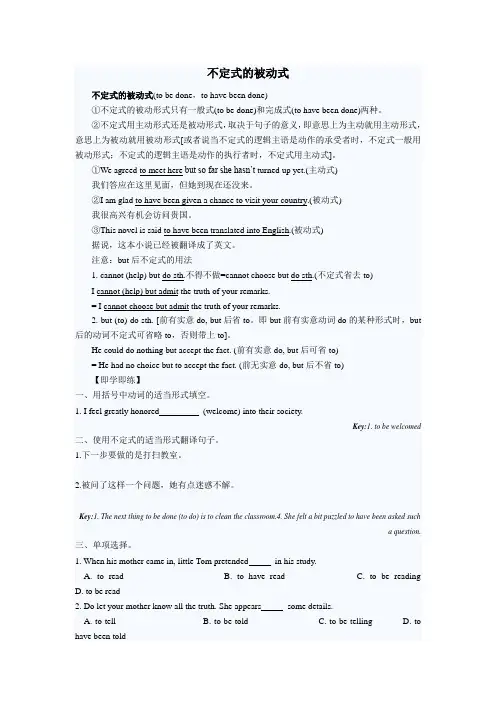
不定式的被动式不定式的被动式(to be done,to have been done)①不定式的被动形式只有一般式(to be done)和完成式(to have been done)两种。
②不定式用主动形式还是被动形式,取决于句子的意义,即意思上为主动就用主动形式,意思上为被动就用被动形式[或者说当不定式的逻辑主语是动作的承受者时,不定式一般用被动形式;不定式的逻辑主语是动作的执行者时,不定式用主动式]。
①We agreed to meet here but so far she hasn’t turned up yet.(主动式)我们答应在这里见面,但她到现在还没来。
②I am glad to have been given a chance to visit your country.(被动式)我很高兴有机会访问贵国。
③This novel is said to have been translated into English.(被动式)据说,这本小说已经被翻译成了英文。
注意:but后不定式的用法1. cannot (help) but do sth.不得不做=cannot choose but do sth.(不定式省去to)I cannot (help) but admit the truth of your remarks.= I cannot choose but admit the truth of your remarks.2. but (to) do sth. [前有实意do, but后省to。
即but前有实意动词do的某种形式时,but 后的动词不定式可省略to,否则带上to]。
He could do nothing but accept the fact. (前有实意do, but后可省to)= He had no choice but to accept the fact. (前无实意do, but后不省to)【即学即练】一、用括号中动词的适当形式填空。
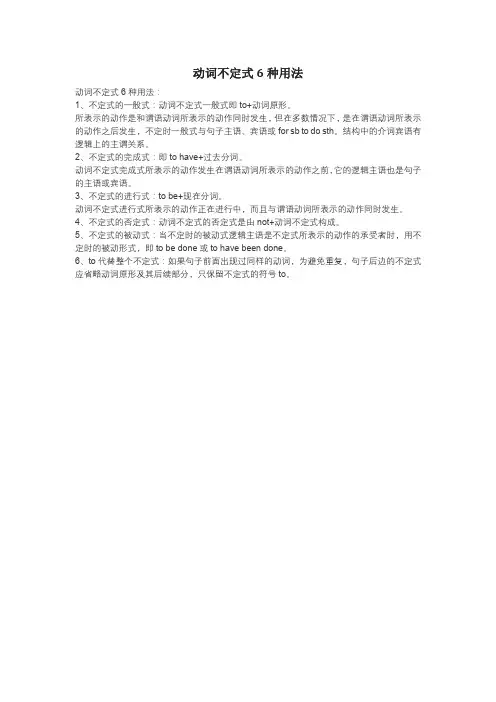
动词不定式6种用法
动词不定式6种用法:
1、不定式的一般式:动词不定式一般式即to+动词原形。
所表示的动作是和谓语动词所表示的动作同时发生,但在多数情况下,是在谓语动词所表示的动作之后发生,不定时一般式与句子主语、宾语或for sb to do sth。
结构中的介词宾语有逻辑上的主谓关系。
2、不定式的完成式:即to have+过去分词。
动词不定式完成式所表示的动作发生在谓语动词所表示的动作之前,它的逻辑主语也是句子的主语或宾语。
3、不定式的进行式:to be+现在分词。
动词不定式进行式所表示的动作正在进行中,而且与谓语动词所表示的动作同时发生。
4、不定式的否定式:动词不定式的否定式是由not+动词不定式构成。
5、不定式的被动式:当不定时的被动式逻辑主语是不定式所表示的动作的承受者时,用不定时的被动形式,即to be done或to have been done。
6、to代替整个不定式:如果句子前面出现过同样的动词,为避免重复,句子后边的不定式应省略动词原形及其后续部分,只保留不定式的符号to。
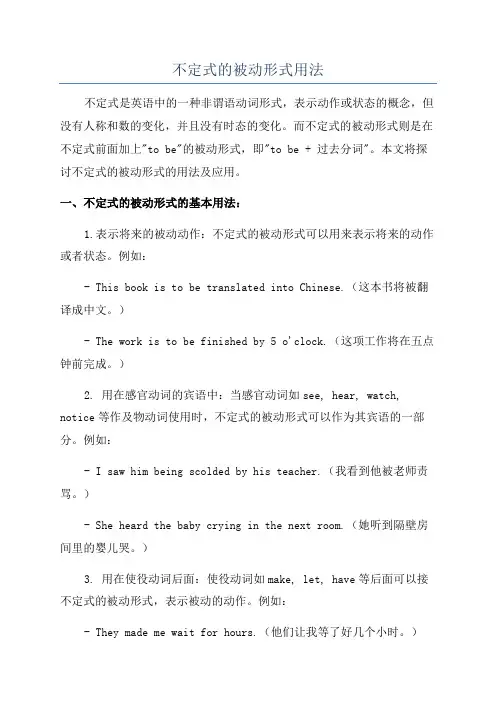
不定式的被动形式用法不定式是英语中的一种非谓语动词形式,表示动作或状态的概念,但没有人称和数的变化,并且没有时态的变化。
而不定式的被动形式则是在不定式前面加上"to be"的被动形式,即"to be + 过去分词"。
本文将探讨不定式的被动形式的用法及应用。
一、不定式的被动形式的基本用法:1.表示将来的被动动作:不定式的被动形式可以用来表示将来的动作或者状态。
例如:- This book is to be translated into Chinese.(这本书将被翻译成中文。
)- The work is to be finished by 5 o'clock.(这项工作将在五点钟前完成。
)2. 用在感官动词的宾语中:当感官动词如see, hear, watch, notice等作及物动词使用时,不定式的被动形式可以作为其宾语的一部分。
例如:- I saw him being scolded by his teacher.(我看到他被老师责骂。
)- She heard the baby crying in the next room.(她听到隔壁房间里的婴儿哭。
)3. 用在使役动词后面:使役动词如make, let, have等后面可以接不定式的被动形式,表示被动的动作。
例如:- They made me wait for hours.(他们让我等了好几个小时。
)- The teacher had the students clean the blackboard.(老师让学生们擦黑板。
)4.用在形容词后面:有些形容词后面可以接不定式的被动形式来表示被动的动作或状态,并且不定式的主语通常是形容词的修饰词。
例如:- I was happy to be invited to the party.(我很高兴被邀请参加派对。
)- She was excited to be awarded first place.(她很兴奋被授予第一名。
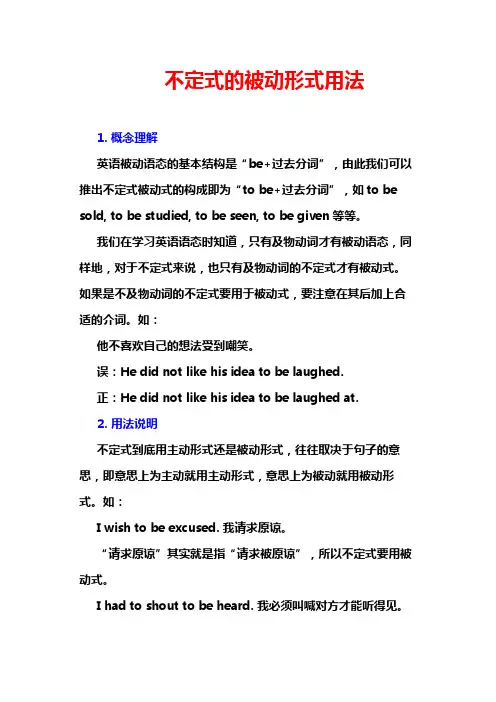
不定式的被动形式用法1. 概念理解英语被动语态的基本结构是“be+过去分词”,由此我们可以推出不定式被动式的构成即为“to be+过去分词”,如to be sold, to be studied, to be seen, to be given等等。
我们在学习英语语态时知道,只有及物动词才有被动语态,同样地,对于不定式来说,也只有及物动词的不定式才有被动式。
如果是不及物动词的不定式要用于被动式,要注意在其后加上合适的介词。
如:他不喜欢自己的想法受到嘲笑。
误:He did not like his idea to be laughed.正:He did not like his idea to be laughed at.2. 用法说明不定式到底用主动形式还是被动形式,往往取决于句子的意思,即意思上为主动就用主动形式,意思上为被动就用被动形式。
如:I wish to be excused. 我请求原谅。
“请求原谅”其实就是指“请求被原谅”,所以不定式要用被动式。
I had to shout to be heard. 我必须叫喊对方才能听得见。
“大声叫”的目的是什么?就是为了被别人听见,所以不定式要用被动式。
Rules were made to be broken. 定了规则就准备有人违反。
.根据常识可知,“规则”与“违反”之间是被动关系,所以不定式用被动式。
He was the last person to be asked to speak. 他是最后一个应邀请发言的人。
“应邀发言”实际意思是“被邀请发言”,所以不定式用被动式。
3. 主动表被动一般说来,表示主动意义,不定式用主动式;表示被动意义,不定式用被动式。
但是,有个别时候,虽然意义上是被动的,但不定式却要用主动式。
如:The house is to let. 此屋出租。
在英语中,to let, to blame这两个不定式在用作表语时,习惯上是用主动形式表示被动意义。
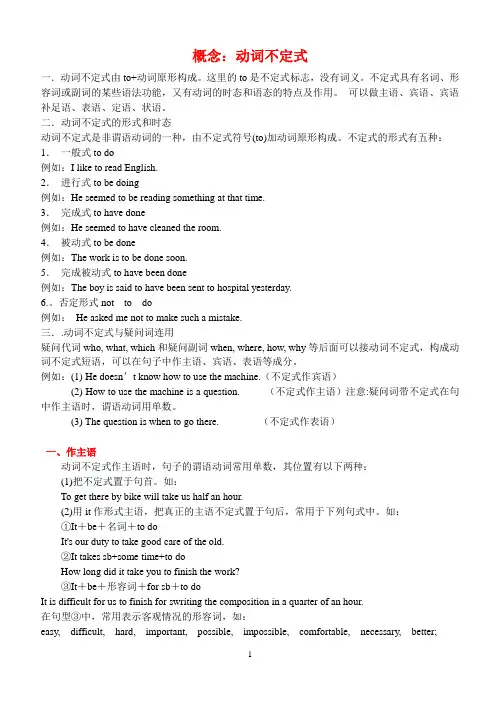
概念:动词不定式一.动词不定式由to+动词原形构成。
这里的to是不定式标志,没有词义。
不定式具有名词、形容词或副词的某些语法功能,又有动词的时态和语态的特点及作用。
可以做主语、宾语、宾语补足语、表语、定语、状语。
二.动词不定式的形式和时态动词不定式是非谓语动词的一种,由不定式符号(to)加动词原形构成。
不定式的形式有五种:1.一般式to do例如:I like to read English.2.进行式to be doing例如:He seemed to be reading something at that time.3.完成式to have done例如:He seemed to have cleaned the room.4.被动式to be done例如:The work is to be done soon.5.完成被动式to have been done例如:The boy is said to have been sent to hospital yesterday.6.。
否定形式not to do例如:He asked me not to make such a mistake.三..动词不定式与疑问词连用疑问代词who, what, which和疑问副词when, where, how, why等后面可以接动词不定式,构成动词不定式短语,可以在句子中作主语、宾语、表语等成分。
例如:(1) He doesn’t know how to use the machine.(不定式作宾语)(2) How to use the machine is a question. (不定式作主语)注意:疑问词带不定式在句中作主语时,谓语动词用单数。
(3) The question is when to go there. (不定式作表语)一、作主语动词不定式作主语时,句子的谓语动词常用单数,其位置有以下两种:(1)把不定式置于句首。
被动语态〔一〕语态是动词的一种形式,用以表示主语和谓语之间的关系。
英语的语态分为主动语态和被动语态。
主动语态表示主语是动作的执行者。
被动语态表示主语是动作的承受者。
★常用的几种时态的被动语态及含有情态动词的被动语态的构成形式★动词不定式的被动式【语境展示】观察下面各句中动词不定式的被动式的用法,然后加以总结。
1. It's nice to be wanted.2. The books are to be sent to the young children.3. She didn't like to be treated as a child.4. The question to be discussed at the next meeting will be a hard nut to crack.5. They were shipped to America to be sold as slaves.6. He didn't want the subject to be mentioned in the letter.7. Forty-one people are said to have been seriously hurt in the accident.【自我归纳】1. 当动词不定式与其逻辑主语之间是动宾关系时,要用不定式的被动式。
动词不定式的被动式有两种:①一般式的被动式:to be done〔句1-句6〕;②完成式的被动式:________〔句7〕。
2. 动词不定式的被动式在句中可以作主语〔句1〕、表语〔句2〕、宾语〔句3〕、________〔句4〕、状语〔句5〕、宾语补足语〔句6〕、主语补足语〔句7〕。
【自我归纳】to have been done;定语【即学即练】I. 用括号内动词的正确形式填空。
1. We’re having a meeting this afternoon. The decision ________ (make) at the meeting will influence the future of our company.2. Having a trip abroad is certainly good for the old couple, but it remains ________ (see) whether they will enjoy it.3. My friend didn’t want the subject ________ (mention) in the letter.4. The machine doesn’t work. It seems ________ (damage).5. The news reporters hurried to the airport, only ________ (tell) the film star had left. II. 用括号内动词的正确形式完成下面短文。
被动语态(Ⅰ):动词不定式的被动式不定式修饰的名词或代词和不定式构成逻辑上的动宾关系,即当不定式的逻辑主语是不定式所表示动作的承受者时,不定式一般使用被动式。
一、动词不定式被动式的构成和意义The next thing to be done is to carry away the earth.下一步要做的事是把土运走。
No harm seems to have been done to them.对他们似乎并没有造成损害。
[考题印证]1①(山东高考改编)George returned after the war, only (tell) that his wife had left him.②(湖南高考改编)We've had a good start, but next, more work needs(do) to achieve the final success.二、动词不定式被动式的用法1.作主语It is an honour to be chosen as a volunteer.能被选上做志愿者,真是一件荣幸的事情。
2.作表语The task is to be finished by next month.这项工作要在下个月才能完成。
3.作宾语The boy asked to be given an opportunity to try again.那男孩要求给他再试一次的机会。
4.作宾语补足语He ordered the baggage to be brought to his room.他吩咐把行李搬进他的房间。
5.作定语He was the last one to be asked to speak at the meeting.他是最后一个在会上被邀请发言的人。
6.作状语His mother left the small village, never to be seen again.他母亲离开了那个小村庄,再也没人见过她。
精心整理动词不定式有两种被动式,即一般式和完成式,例如do的被动式有tobedone,tohavebeendone。
只有及物动词和相当于及物动词的短语才有不定式的被动式。
一般说来,当不定式的逻辑主语是不定式动作的承受者时,该不定式要用被动式。
例如:况:1)系。
否则,在表示被动意义时,仍需要被动式。
试比较: Haveyouanythingtodothisafternoon?今天下午你有事要做吗?(todo是由you发出的)Haveyouanythingtobetakentoyourparents?你有要带给你父母的东西吗?(谁带不得而知)再如:Pleasegetmesomethingtoread.请给我弄点读的材料。
He'llshowyoutherightpathtotake.他会给你指出要走的正确的路。
2)3)在此句型中,用来修饰主语的不定式,可用主动式,也可用被动式,只是侧重点不同。
用主动式作定语,重点在人,用被动式作定语,重点在物。
例如:没有时间可以耽误。
可译成:Thereisnotimetolose(tobelost).用tolose可看成forustolose;用tobelost,谁losttime不明确。
但下述两句用主动不定式与被动不定式意义不同:a.Thereisnothingtodonow.(=Wehavenothingtodonow.)现在没事干。
1)Thejobisveryeasytodo.这工作很容易做。
2)n.+be+too+adj.+todoThethingistoosmalltosee.这东西太小看不见。
Iwastooexcitedtosayaword.我激动得连一句话也说不出。
3)例如:Thehouseistolet.这房子要出租。
Whoistoblameforit?这得怪谁?Thereasonisnotfartoseek.这理由不难找到。
练习:选择填空。
c.tobetypedd.typed5.Thecarisratherdifficult__________.a.torepairb.toberepairedc.repairingd.beingrepaired6.Hewasnowhere__________.a.toseeb.tobeseenc.seeingd.seen。
非谓语动词之动词不定式被动语态形一、复习各种时态的被动语态★被动语态的基本结构: be+ done(以the book , publish 为例)一般现在/过去时:The book is/ was published.一般/过去将来时:The book will/would be published.The book is/was going to be published.现在/过去进行时:The book is/was being published.现在/过去完成时:The book has/had been published.情态动词:The book can/could/may/might…be published.1)一般式:(not/never )to be done2)完成式:(not/ never)to have been done (表示不定式动作发生在谓语动词之前)三、▲通常在believe, suppose, say, report等动词构成的句子中可以进行主动语态到被动语态以及被动语态和动词不定式的转换.如:They say that Mike is sick in bed.=It is said that Mike is sick in bed.=Mike is said to be sick in bed.据说麦克卧床不起.People believe that he was killed.=It is believed that he was killed.=He is believed to have been killed.大家相信他被杀了.四、当不定式的逻辑主语是不定式所表示的动作的承受者而非发出者时,不定式一般要采用被动形式(to be done).语法功能:1.作主语:It is an honour for me to be asked to speak here.2.作宾语:She asked to be sent to work in Xinjiang.3.构成复合宾语:He wanted the letter to be typed at once.She didn’t like herself to be praised like that.4.构成复合谓语:The books are not allowed to be taken out of the room.5.作定语:Are you going to the meeting to be held in the teachers’ office?6.作状语:She was too young to be assigned such work.五、不定式有时还可以有完成式的被动式to have been done(表示该动作是发生在主句之前的一个被动动作),在句中作主语、宾语、定语,或者构成复合宾语、复合谓语等,如:It is a good thing for him to have been criticized.(主语)She preferred to have been given heavier work to do. (宾语))He thought it an honour to have been invited to the party. (复合宾语)The book is said to have been translated into many languages. (复合谓语)She was the first woman to have been elected to such a post. (定语)六、不定式的主动形式表示被动1.There be 结构中,用不定式的主动和被动式来修饰主语,区别不大。
动词不定式的主动形式表被动含义通常情况下,动词不定式的主动形式表示主动意义,被动形式表示被动意义。
但在某些情况下,动词不定式的主动形式表示被动意义。
请看下列几种结构:1. 在“主语+ 谓语(及物动词)+ 宾语+ to do ”结构中,动词不定式与宾语之间有逻辑上的动宾关系,句子的主语与动词不定式又有逻辑上的主谓关系。
因此,用动词不定式的主动形式可以表示被动意义。
例如:She has a meeting to attend. 她有一个会议要参加。
宾语a meeting 与动词不定式to attend 有逻辑上的动宾关系,主语She 与动词不定式to attend 又有逻辑上的主谓关系,故用动词不定式的主动形式表示被动意义。
又如:The man has a large family to support. 这个人要养活一大家子人。
2. 在“主语+ 谓语(及物动词)+ 间接宾语+ 直接宾语+ to do ”结构中,动词不定式与直接宾语之间有逻辑上的动宾关系。
因此,也可以用动词不定式的主动形式表示被动意义。
例如:I'll give him some books to read. 我要给他一些书看看。
直接宾语some books 是动词不定式to read 的逻辑宾语,间接宾语him 是动词不定式to read 的逻辑主语。
又如:He set us a good example to follow. 他为我们树立了学习的好榜样。
3. 在“主语+ 谓语(及物动词)+ 宾语+ 宾补+ to do ”结构中,宾语是动词不定式的逻辑宾语,而句子的主语可能是动词不定式的逻辑主语,也可能不是。
此时,也用动词不定式的主动形式表示被动意义。
例如:I found the fellow hard to get along with. 我发现那家伙很难相处。
He made his lessons easy to understand. 他的课让人容易理解。
动词不定式有两种被动式, 即一般式和完成式, 例如do的被动式有to be done, to have been done。
只有及物动词和相当于及物动词的短语才有不定式的被动式。
一般说来, 当不定式的逻辑主语是不定式动作的承受者时, 该不定式要用被动式。
例如:He asked to be sent to work in that factory. 他要求派他去那个工厂工作。
These books are not allowed to be taken out of the room. 这些书不许带出室外。
但在某些情况下, 不定式虽然表示被动意思, 用的却是主动形式。
常见的有下列几种情况:一、在某些固定句型中, 动词不定式作定语, 用主动形式表被动意义。
1)have(give, show)sth. to do在这种句型中的不定式与前边的名词有动宾关系, 又和句中另一名词或代词构成主谓关系。
例如: I have a lot of things to do this afternoon. to do与things是动宾关系, 与I是主谓关系。
否则, 在表示被动意义时, 仍需要被动式。
试比较:Have you anything to do this afternoon? 今天下午你有事要做吗?(to do是由you发出的)Have you anything to be taken to your parents? 你有要带给你父母的东西吗? (谁带不得而知)再如:Please get me something to read. 请给我弄点读的材料。
He'll show you the right path to take. 他会给你指出要走的正确的路。
2)It(This, That)+be+a/an+adj. +n. +to do在这种句型中, 不定式与前面的名词有动宾关系。
动词不定式可改为动词不定式复合结构。
•不定式的被动式的概念:
如果不定式的逻辑主语是不定式所表示的动作的承受者,不定式要用被动式。
如:The next thing to be done is to get our classroom pained.
•不定式被动式的用法:
一、基本形式:
不定式被动式的基本形式为to be done;若表示动作先于另一动作之前,则用完成式,即to have been done。
二、用法归纳:
不定式被动式在句中可以用作:
1、主语:
如:It's a great honour to be invited to the banquet. 承蒙邀请赴宴,甚是荣幸。
To be attacked by the enemy is not a bad thing, but a good tiring. 被敌人反对是好事,不是坏事。
It's a pity to be kept in the house in fine weather. 好天气时被留在家里是很遗憾的。
2、表语:
如:All this is to be sold. 所有这些都是出售的。
Water must be pure if it is to be drunk. 水如供饮用必须净化。
The switchboard is to be manned at all times. 任何时候电话总机那儿都应有专人在岗负责。
3、宾语:
如:She doesn't want to be separated from him. 她不愿和他分开。
He begged to be allowed to return to Brazil. 他恳求允许他返回巴西。
I don't wish to be disturbed in my work. 在工作时我不愿意被人打扰。
They demanded to be shown the authentic documents. 他们要求出示真实可靠的文件。
4、定语:
如:I made notes of the things to be mended. 我记下了需要修补的东西。
The Blacks are the first to be fired and the last to be hired. 黑人是最先被解雇,最后被雇用。
5、状语:
如:He asked to be kept in formed about developments. 他要求随时向他报告发展情况。
As she waited to be served, she became very impatient. 她在等候侍者送饭时,很不耐烦。
She got there only to be told that they had gone on holiday. 她到达那里,被告知他们度假去了。
6、宾语补足语:
如:He did not like his intention to be laughed at. 他不喜欢自己的意图受到嘲笑。
He ordered the goods to be sent by air. 他命令把货物空运
7、主语补足语:
如:The court was ordered to be cleared. 有命令要关闭法庭。
The books are not allowed to be taken out of the room. 不许将书携出室外。
8、用在“for+名(代)词+不定式”结构中。
如:It's an honour for me to be asked to speak here. 我很荣幸被邀在这里讲话。
It is essential for him to be prepared for this. 有必要让他对此有所准备。
It's impossible for the job to be finished in time. 这项任务要按时完成是不可能的。
The note was a simple request for a porter to be sent to room201. 这个字条就是请指派一个搬运工到201室去。
Can you arrange for the gold to be delivered on Monday? 你能不能安排一下周一把金子送到?
•动词不定式的被动式之注意点:
一、注意形式与功用:
不定式的被动式为“to be+过去分词”,表示其逻辑主语是动作的承受者,具有被动含义。
在句中可用作主语、表语、宾语、定语、状语、补语等。
如:It was impossible for lost time to be made up. 要弥补已失去的时光是不可能的。
I hope to be invited to the party. 我希望有人请我去参加晚会。
Have you got ready for the meeting to be held? 你为即将举行的会议准备好了吗?
In order to be chosen, he sent each of them a present.为了被选中,他给他们每人都送了礼物。
The problem seems to be solved soon. 问题好像快要解决了。
二、与不定式的主动式的比较:
1、表示义务的概念,句子的主语是要做的动作或接受动作的人或物时,要用不定式的被动式。
如:These sheets are to be washed. 这些床单要洗一洗。
The cleaning is to be finished by mid day. 要在中午前打扫完毕。
2、不定式作定语与被修饰词是主谓、动宾、同位等逻辑关系时,多用其主动式。
如:Where is the boy to speak at tomorrow's meeting?(=who will speak at tomorrow's meeting主谓关系) 明天要在会上发言的那个男孩在哪里?
I have got a letter to write.(=that I will write动宾关系,尤其谓语动词为have, give, bring等时) 我有封信要写。
Give me a pen to write with.(=that I can write with不及物动词加上相应的介词)给我一枝笔写。
注意:如果动作的执行者在主语或宾语中没有出现,应用不定式的被动式。
如:I'm going to the post office. Do you have any letters to be posted? 我要去邮局。
你有信要寄吗?(动作执行者不是you)
3、在there be结构中,用不定式的主动式和被动式意义一般差别不大,但有些还是有差别的。
如:There's a lot to be said (或to say) about this book. 关于这本书大有可说。
There is nothing to see. 没有什么可看的了。
There is nothing to be seen. 看不见有什么。
(即“什么也没看见”)
4、修饰作表语或宾补的形容词的不定式,常用主动式表示被动含义。
如:I don't think English hard to learn. 我认为英语不太难学。
三、双重被动结构有些被动结构后接不定式作宾语、宾语补足语等时,仍然含有被动含义,就得用双重被动结构:
如:The work is thought to be finished soon. 大家认为工作很快就完成了。
四、动作发生的时间不定式多表示未来动作或情况,其被动式也不例外,上述各例皆有体现,尤其是改为定语从句时多为将来时的被动语态。
另外我们还要注意以下两点:
1、表示被动关系时,当不定式的动作先于谓语时,可用不定式的被动式的完成时:to have been done;
与谓语同时进行时,要用不定式的被动式的进行时:to be being done。
如:The dead woman is said to have been badly treated. 据说死去的妇女受虐待。
Rain forests are reported to be being cut down rapidly. 据报道雨林正被迅速地砍伐。
2、不定式的主动式作含序数词的被修饰词语的定语时,可表示已完成的动作。
如:He was the first man to taste the tomato. 他是第一位品尝西红柿的人。
They were the last to leave the countryside.他们是最后一批离开农村的。